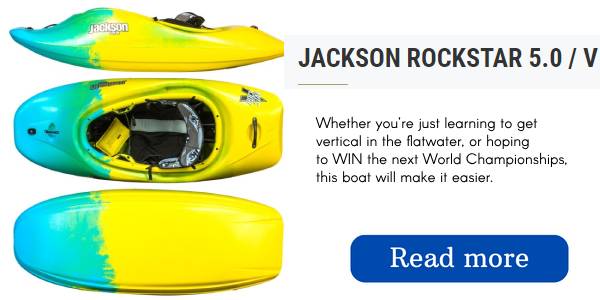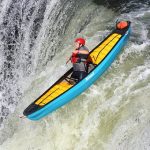The average kayak speed is not constant, but rather fluctuates depending on the time of day, the experience of the paddler, and other conditions.
The speed of a kayak varies depending on the location and the experience of the person paddling. An experienced paddler can go about 8 mph while a novice might only be able to go about 3 mph.
Recreational kayakers typically reach speeds of 3 knots or more, which is the average speed. This is much faster than the average walking speed of 2 knots. If the current you’re paddling in is stronger than 4 knots, it’s time to take precautions and paddle carefully.
Experienced kayakers can paddle at speeds of 6-7 kilometers per hour, or even faster.
Even though there are some things that can affect how fast you go kayaking, like the weather or how experienced you are, there are ways to improve your speed.
CONSIDERING THE TYPE OF KAYAK
Modern kayaks generally fall into one of the following categories: touring boats or sea kayaks, whitewater kayaks, surf kayaks, racing kayaks, fishing kayaks, or recreational kayaks. The kayak you use will affect your kayaking speed. In general, kayaks that are wider will be slower than narrow kayaks.
The fastest boats tend to have a beam of 22 inches or less and a hull shape that is very rounded (to minimize resistance). Similarly, longer kayaks are typically faster than shorter kayaks. The fastest type of kayak available is the long, sleek touring kayak, followed by the shorter recreational kayak, and then the wide fishing kayak.
On flat water, a sprint kayak is able to travel faster than any other human-powered vessel. Sit-inside kayaks are usually faster than sit-on-top kayaks because they have a lower center of gravity, which decreases wind resistance.
Lighter kayaks accelerate more quickly, but they are not as strong as heavier kayaks and therefore do not move as swiftly through windy conditions. Even though they are light, some kayaks can move pretty quickly, depending on what they are made of.
For example, model made from fiberglass, carbon fiber, and diolen composites tend to be faster than a model made from polyethylene. This is because the boat is very rigid. The more flexible a boat is, the more drag it will create.
The most commonly used kayaks are paddle kayaks. Though they are popular and well-known, these kayaks are typically much slower than peddle versions like the Hobie Outback. Choose a kayak that will fit your skill level and needs.
CONSIDERING THE DISTANCE
The speed of a kayak when traveling long distances is mostly determined by how long the paddler can keep going. Start with a slow and steady pace when kayaking long distances. Instead of trying to go as fast as you can, try to maintain a stroke that is consistent and that you can keep up for up to an hour.
If you are going to be kayaking for multiple days in a row, you need to make sure you are physically capable of completing the journey. The first few days will be tough in terms of energy levels, so plan on travelling more slowly after a while.
This means you should make sure you are eating and drinking enough so you can maintain your speed without over-working yourself.
CONSIDERING THE BODY OF WATER
The kind of water you paddle on has an impact on how fast you can kayak. Kayaking over rough, open water is much more difficult than paddling down a calm river or stream.
Paddling against a water current significantly slows down your speed. If you are paddling at the same speed as the current, you will not move. If you paddle slower than the current, you will move backwards.
If you are going against the current, you will move slower than your average speed. However, if you are going with the current, the current will help push you along and you will be able to move faster than your average speed.
When planning a kayaking trip, it is important to research the average water speeds in the area to ensure a safe and enjoyable journey. Doing a job that is too difficult for your skill level can be frustrating. Make sure you select a job that is appropriate for your skill level to avoid frustration.
Kayak Type
The length of the keel is the most important factor in determining a kayak’s speed. The longer the keel is, the faster the boat will go in general.
Instead of speedboats, which glide over the water, kayaks move through the water by displacing it. As the kayak moves through the water, it creates a wave that extends from the front of the boat to the side. Longer kayaks create a longer wave.
Boats that are propelled by hull displacement have difficulty overcoming the riding wave that is created in front of the boat. The longer the wave, the faster the kayak can go because it has more time to travel before it reaches the wall of water.
A longer keel will produce a longer wave, and a longer wave will travel faster.
There are two types of kayaks, sit-in and sit-on-top. There are two main types of kayaks – those with long keels and those with short keels. However, there are many other factors that can affect a kayak’s speed in addition to the length of its keel.
The biggest of these is kayak width. Narrow boats create less drag when moving through the water and require less force to maintain speed. Touring kayaks are long and narrow so that they can be used for extended journeys.
Sit-on-top kayaks are almost always wider than sit-in models. Sit-on-top kayaks have seats that are higher up from the water than sit-in kayaks, which gives the person paddling it a higher center of gravity when they are seated.
Because kayaks are thinner than canoes, they are not as stable. To make up for this, they are wider, which makes it harder to paddle fast.
Paddle Type
If you have just spent a lot of money on a new kayak, you may be tempted to save money by buying a cheaper paddle. I would suggest that you think about your decision before using your credit card. There are many types of paddles available for purchase today.
If you are looking to maximize your speed, it could make a big difference.
The price of a kayak paddle is directly proportional to its weight.
Plastic and aluminum paddles are heavy, durable, and economical. This makes them great choices for recreational paddlers or kids who want to paddle around. But after continued paddling for several hours, even a small amount of extra weight can have a harmful effect on your arms and shoulders.
Paddles made out of fiberglass or carbon fiber are more fragile than other materials, but they are still durable. These paddles are also noticeably lighter. If you want to improve your endurance and technique, you should switch from plastic paddles to carbon fiber paddles.
Some of the paddles for this sport can be as expensive as a recreational sit-on-top kayak, so be sure you are committed to the sport before you spend the money upgrading your equipment.
When it comes to blade width, you may expect a wider blade to give you more power. A shorter, narrower blade will be lighter, and easier to paddle for longer periods of time. A shorter, narrower blade is lighter and easier to paddle for longer periods of time.
The wider paddle will not wobble as much when cutting through the water and will be easier to control. This paddle is better for newer paddlers, even though it requires more effort.
What Is The Function Of Vessels In A Kayak?
A kayak is a small, narrow boat that you sit inside and paddle with your hands. The narrower the kayak, the faster you will be able to travel.
Does Kayaking Have Any Health Benefits?
Kayaking is a low-impact activity and is perfect for people who cannot do strenuous workouts. Kayaking is great for improving your cardiovascular system. In addition to helping you build muscle mass on your chest, arms, shoulders, and back, dumbbells can also help improve your muscle definition.
Since it is a type of activity that is low-impact, it puts less stress on your tissues and joints. Kayaking can help improve your leg and torso strength as you need to rotate the vessel using leg pressure.
How Can I Improve My Kayak Speed?
There are some essential steps you need to follow if you want to go faster in your kayak. You need to increase your strength and stamina if you want to kayak well. With this, refine your technique of paddling. The more times you refine your kayak, the more it will help your speed.
In addition to working on your own kayaking skills, you can modify the equipment you have to make it more efficient (i.e. by adding sails to your kayak). Choose a lightweight swinging paddle. This will enable you to manage the speed conveniently.
A long, narrow kayak will minimize friction and help you move faster.
In What Way Does The Wave Resistance Influence The Speed Of The Kayak?
A kayak creates two different types of waves when it moves across a body of water. There are two types of wave fans that can be created by a kayak. The first type is created by the bow of the kayak and is called a divergent wave. This type of wave affects the person in the kayak.
The next wave is the transverse wave, which emerges perpendicular to the side of the kayak that it is moving. The transverse waves bring you the energy that is lost as the water moves from one side to the other and back again.
Kayaks move more slowly when they encounter waves because the waves increase resistance. The wave resistance can impact kayakers moving above four knots.
What Are The Major Characteristics Of Kayaks That Determine The Wave Resistance?
Each type of kayak has different characteristics, such as the length and width of the hull, that can affect how well it handles in waves.
What Are The Ways Of Improving Paddling Technique For Faster Kayaking?
Paddling with the right technique can help you go faster in a kayak without putting in a lot of effort. So, firstly analyze the numbers of horsepower and speed. If you want to move at an average rate of 3.5 mph, your body needs to be able to produce 0.02 to 0.03 hp.
This situation indicates that walking is generally not an effort for fit humans. But, if you want to increase your speed to five to six knots, you will need to generate nearly 0.1hp to 0.2hp.
Some Other Essential Techniques You Can Follow To Improve Your Paddle Techniques Are…
1. Maintain the right position of your body. First, sit in the given seat, and then position yourself with your feet balls pressing against the braces or pegs firmly. Now check whether the adjustment of your seat is comfortable for paddling or not. If not, please make the necessary adjustments.
2. Bending your knees in a diamond shape and pressing your thighs next to the thigh braces will help you paddle better in a sit-in kayak. If you are on a sit-on-top kayak, press your thighs opposite to the kayak itself.
3. If you sit in the right position, your upper torso will be able to move more freely, and you’ll be less likely to injure your shoulder. This will not only provide more support, but will also increase the area of contact with the kayak, resulting in better control.
4. To avoid tiring out quickly, use not only your arm muscles but also large muscles elsewhere in your body. Additionally, keep the Paddler’s Box in mind. It is a box that you create to hold the paddle and your hands in the front of the torso. Rotate your torso while continuing to paddle in order to keep the box stable. This technique helps keep the shoulders in the sockets.
5. You should try to use both pushing and pulling motions with your paddle instead of just pulling it. To start rowing, pull the lower paddle blade into the water near your toes and stretch your high blade into the air away from your side. This technique helps you to travel quickly through the water for a long time without releasing more energy.




